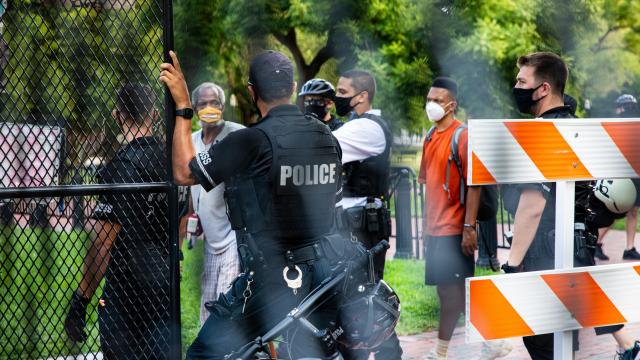At an otherwise peaceful protest in Washington, D.C. this past June, one attendee is alleged to have punched an officer in the face before fleeing. According to court documents reviewed by The Washington Post, police found their culprit by mining mobile phone footage from the protest posted on Twitter, using a previously unknown facial recognition program.
The Post describes that the individual — Michael Joseph Peterson Jr — was identified after the Twitter footage was fed through the National Capital Region Facial Recognition Investigative Leads System (NCRFRILS) a pilot program of the suburban Maryland nonprofit Metropolitan Washington Council of Government. Searching online for anything related to the NCRFRILS won’t turn up much, even though it has allegedly been active since 2017 and has been used by more than a dozen federal agencies. A Council spokesperson told the Post that NCRFRILS was never publicly announced because the program is still in a test phase.
Still, the facial match producted by NCRFRILS, along with a backpack found at the scene of the crime containing one of Peterson’s ID cards, solidified him as the suspect.
This is far from the first time that federal authorities have been caught engaging in domestic surveil people against protesters. Nor is it facial recognition’s debut seeking out alleged ne’er-do-wells at such events: in August, an NBC News investigation revealed that Miami police used it to identify a woman accused of throwing rocks at an officer mid-protest; that same month, the Post found Philadelphia police allegedly turning to this software to track down protestors accused of vandalizing police cars; police in New York confirmed roughly a week later that they, too, used similar software to find a protestor who allegedly shouted into an officer’s ear with a bullhorn.
Fairfax County Police Major Christian Quinn, who heads the NCRFRILS program, told the Post that because the software is only used to generate leads in investigations, its use doesn’t need to be disclosed to the defendant in question. He also claimed the software is not used to surveil peaceful protests. According to Quinn, the 1.4 million images that make up the NCRFRILS database are derived from mugshots supplied from partnering agencies. This isn’t especially reassuring: The month of the incident in D.C.’s LaFayette Square, more than 10,000 protestors were alleged to have been arrested, many of whom were charged with non-violent misdemeanours like breaking curfew, and the subsequently not charged.
The Post states that NCRFRILS has been used over 12,000 times since 2019, and Quinn told the paper the system has generated around 2,600 leads. He was not able to state how many of those leads resulted in an arrest.
